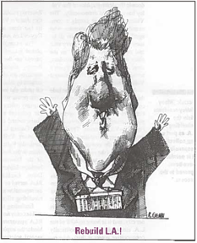By Benjamin M. Reznik who is a land-use attorney and partner with the Sherman Oaks law firm of Reznik and Reznik.
When first formed, Rebuild L.A. (RLA) was subjected to a great deal of criticism from numerous groups who claimed that they were being excluded from this important community effort. They argued that without their involvement, a true healing of this city could not take place and permanent solutions could not be found.
RLA responded by purporting to create an inclusive organization representative of the people of Los Angeles. However, in its effort to be inclusive of these various groups, RLA has forgotten one rather large and important constituency — the entire San Fernando Valley.
Valley Excluded from RLA
In speaking of the “Valley”, I am mindful of the fact that during the past decade the demographics of the Valley have changed dramatically. The Valley is no longer simply a community of white suburbanites who speak with a unified voice on all issues. Rather, it includes every race and ethnicity that is found “on the other side of the hill.” Nevertheless, there is no denying that there exists a sense of “Valley” identity amongst Valley residents.
Why is it so important to include the Valley in RLA and what are the consequences of not doing so? RLA’s board of directors, now some 80 people strong, includes only one San Fernando Valley person. This lack of any Valley representation is similarly reflected in the composition of the membership of the various task forces created by RLA lo help implement its agenda.
The exclusion of the Valley from RLA reinforces the negative notion that revitalizing and rebuilding our inner city is not a responsibility to be shared by the Valley. The Valley is geographically isolated from the inner city, and it is home to 40% of the L.A. electorate (the more politically conservative voters at that). As a result, one would think that responsible and visionary efforts to rebuild our city would be mindful to include the Valley in the process so as to involve Valley residents in becoming part of the solutions to our city’s problems.
The Impacts of Exclusion
Historically, the Valley has distrusted the Downtown power structure which it views as only being interested in the Valley as a tax base. Recently published audits confirm the fact that the Valley has not received its fair share of resources from the City of Los Angeles.
For example, the recently completed school redistricting, which carved up the Valley districts and thereby diluted the Valley’s representation on the school board, was created by a Los Angeles City Council under the influence of the Downtown power structure. These as well as many other examples demonstrate the political alienation which has characterized the Valley’s relations with Greater L.A.
Many Valley residents, and in particular Valley community leaders, share in the feeling that the concerns of the Downtown politicians and business leaders stop at Mulholland Drive. Excluding the Valley from RLA serves to perpetuate this political separation and can only hinder the rebuilding effort.
Excluding the Valley from RLA will not only limit the effectiveness of RLA’s programs but will also serve to hinder the implementation of governmental solutions which require the Valley’s support in order to be implemented.
An excellent recent example is the defeat of Proposition N by Valley voters. Here we had a measure designed to increase the police force by 1,000 officers, to be financed by a relatively small property tax increase. Yet the Valley, feeling little or no connection to South-Central L.A., and being suspicious that few or none of the 1,000 new officers would be deployed in the Valley, caused this measure to fail. South-Central, meanwhile, may interpret the Valley’s vote as being a slap in the face or as callously indifferent to its needs for more police protection and services.
A Collective Responsibility
One way this lack of understanding can be minimized is to bring the Valley more into the process, thereby increasing the objective of bilateral sensitization (i.e., City sensitivity to Valley concerns and Valley sensitivity to City concerns). One sure way to ensure no progress is to remain separate and uninvolved with each other. Currently there is a failure of community and political leadership in this regard.
I realize that RLA is not a governmental entity. Nevertheless, because of the large number of elected officials who serve on its board, RLA has become a symbolic “shadow government” with a sweeping public mandate to rebuild L.A. The task is so monumental that it is critically important to include representatives from the Valley in this process. Many Valley residents view the rebuilding of L.A. as part of our collective responsibility. It is painful to have been ignored in the process.
- Log in to post comments




